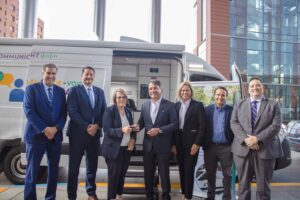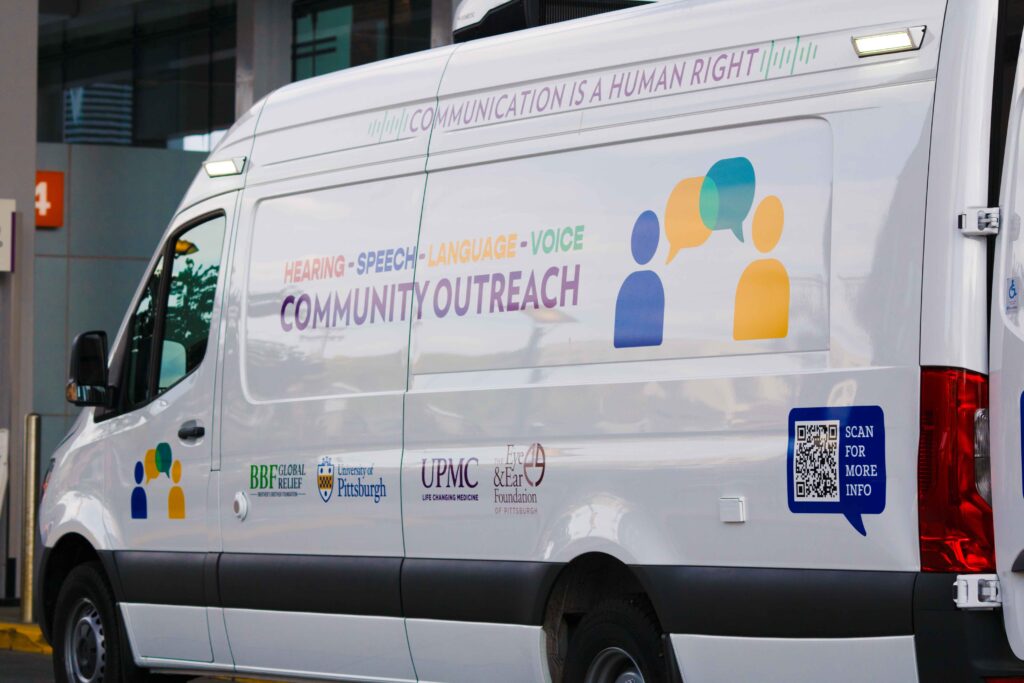Sight + Sound, Fall 2025
The Eye & Ear Foundation held a key exchange event on Tuesday, September 16th at the UPMC Mercy Pavilion, future home to the Hearing Institute. Dr. Catherine V. Palmer, PhD, Director, UPMC Audiology, officially accepted the keys to the new Communication Van from Ozzy Samad, President of Brother’s Brother Foundation (BBF). BBF donated the van to the Eye & Ear Foundation to be used in the community to provide support to improve communication through clinical and research activities. This will include free hearing screenings and testing as well as free hearing aids.

In addition, the University of Pittsburgh’s Department of Communication Science and Disorders faculty will utilize the van to bring research projects out into the community to better understand the needs of people experiencing speech, hearing, language, and voice challenges. Dr. Palmer was joined by UPMC audiologists and members of the faculty in the School of Health and Rehabilitation Sciences, including Dr. David Beck, Interim Dean.
“The Communication Van is officially on the road – providing hearing care, including free hearing aids in neighborhoods around the greater Pittsburgh area as well as reaching out to our rural neighbors,” Dr. Palmer said. Elaine Mormer, PhD, CCC-A, Professor in the Department of Communication Science and Disorders, has been teaming up with rural community pharmacies. The plan is to partner with them to have a hearing clinic in their parking lot once a month to really expand reach. This will likely not start until spring.
Recent Communication Van visits have included Sharpsburg’s Roots of Faith events, City Theatre Community Connects. Future plans include partnering with the Carnegie Library, local schools focused on underserved youth, and the Special Olympics. While the Special Olympics has always provided hearing testing, the Communication Van will allow on-site hearing aid fitting and care for athletes who need hearing aids or already have hearing aids that need maintenance. “We’re very much following the model of our EyeVan colleagues as we’re teaming up where events are already happening for people who are under resourced and need access to these services,” Dr. Palmer said.
Early detection and treatment of hearing issues can dramatically improve communication, social engagement, mental health, and overall quality of life. For children, identifying and treating hearing problems early can support communication and learning.
Many individuals face significant barriers to hearing and communication care, including transportation challenges, lack of funds since hearing aids are not typically covered by insurance, or simply not knowing where to go or who to trust. By eliminating the need to travel to a traditional clinic or research lab, the Communication Van brings professional hearing and communication evaluations straight to neighborhood centers, senior residences, schools, and community events – meeting people where they are.
“The Communication Van covers a big gap for people who have access to care-related issues,” said Lawton Snyder, CEO of the Eye & Ear Foundation. “We have wonderful facilities and services within our hospital system; however, it is difficult for some people to get to us. This brings the care to the community and gives people an opportunity to get the same level of service they could get if they had the ability to make it to us on a regular basis.”
Not surprisingly, patients have responded to the van with excitement. The van’s colorful design gets it noticed. Any service related to hearing is provided – including hearing testing, hearing aid fittings, hearing protection, and even showing people smartphone capabilities like speech-to-text.
“Our colleagues in speech, voice, and language will be using the van similarly,” Dr. Palmer said. Specifically, Dr. Will Evans (SHRS) is interested in expanding care for individuals with aphasia (speech and language problems common after stroke) who may not access this essential care because of insurance, travel and transportation issues.
The Van is unique because it serves many different communication needs in from both a clinical and research perspective. Colleagues who run large research programs will be using the van to move that research out into the community. Amanda Hampton Wray, PhD, CCC-SLP, convinced Dr. Palmer of the importance of this. Her research on stuttering has changed the landscape, yet in the studies, the kids are primarily children of university professors because that is who can come to the lab. “We need a much broader look when we’re trying to do research that’s actually going to impact care,” Dr. Palmer said. “We’re really excited to do that.”
Dr. Palmer talked about interviewing friends with vans. “It’s always a hearing van, very specific, and usually obtained through research projects,” she said. “When the research funding ends, the van sits idle. It really helped us to talk to our colleagues to think about how we’re going to do this differently. It’s because of the Eye & Ear Foundation and Brother’s Brother commitment that there will be ongoing funding for these efforts. If you don’t have that in place, it’s nice for a year and then it’s gone. That won’t be the case here.”
The Brother’s Brother Foundation has been working with mobile clinics and community organizations like EEF and UPMC because, “from our perspective, they’re really the ones making the impact on the ground,” Samad said. “The need locally here is quite honestly in many ways just as apparent as it is in far off lands.”
The van is highly customized. Brother’s Brother worked with the Audiology group and the faculty in Communication Science and Disorders to design every nuance of the inside. They even went to the factory so Dr. Palmer could convey what she wanted. An example is the lift in the back of the van. A patient thought they would not be able to get their hearing tested in the Communication Van because of their wheelchair. Dr. Palmer was able to tell them, “Yes you will.” “This is something simple we might take for granted that is extremely meaningful to those who are in need,” Samad said.
